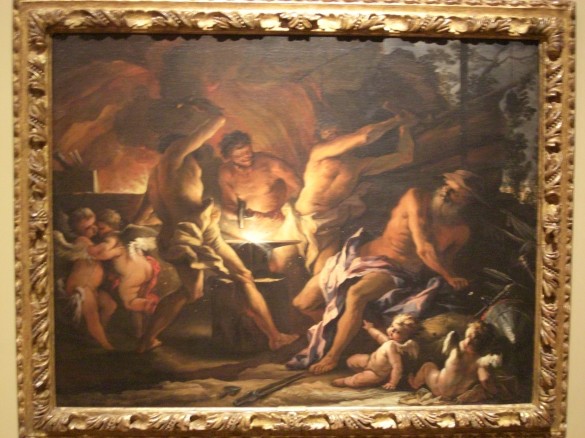Written by Jocelyn Boigenzahn, Curatorial Intern
Exemplifying the rising interest in mythological subject painting in the Baroque period, The Cummer possesses two great examples of Baroque epic paintings by Alessandro Gherardini. Set side by side on the Semmes Gallery wall, we have the Triumph of Neptune and Amphitrite and The Forge of Vulcan, which draw from two works of Latin literature.

Alessandro Gherardini (Italian,1655 – 1723), Triumph of Neptune and Amphitrite, c.1688 – 1689, Oil on canvas, 30 1/4 x 39 7/8 in., Gift of Mr. and Mrs. Kendrick Guernsey, AG.1972.16.1.
The Triumph of Neptune and Amphitrite is described in detail in Ovid`s Metamorphoses. In the work, Neptune is shown with his wife, Amphitrite, who he pursued far and wide across the seas before winning her. After much persuasion, she consented to become Neptune’s wife, and in this painting we see the couple united in their role as rulers of the sea, accompanied by a Nereid and assisted in their journey by wind gods. Above them hovers a putto representing Cupid. In its broadest sense, the painting represents the Triumph of Love.

Alessandro Gherardini (Italian,1655 – 1723), The Forge of Vulcan, c.1688 – 1689, Oil on canvas, 31 3/8 x 40 1/2 in., Gift of Mr. and Mrs. Kendrick Guernsey, AG.1972.15.1.
The Forge of Vulcan represents an episode in Book VIII of Virgil’s Aeneid where the Cyclops are fashioning armor for Aeneas. This work is very dark and typically of the Baroque period there is one source of light in the scene, the fire of the forge. Vulcan, the god of fire, is best known for his role as the blacksmith of the gods and goddesses. According to myth, Vulcan forges the most iconic elements of Greek mythology, such as Zeus’ thunderbolt, Athena’s helmet, and the armour of Achilles in Homer’s Iliad.


